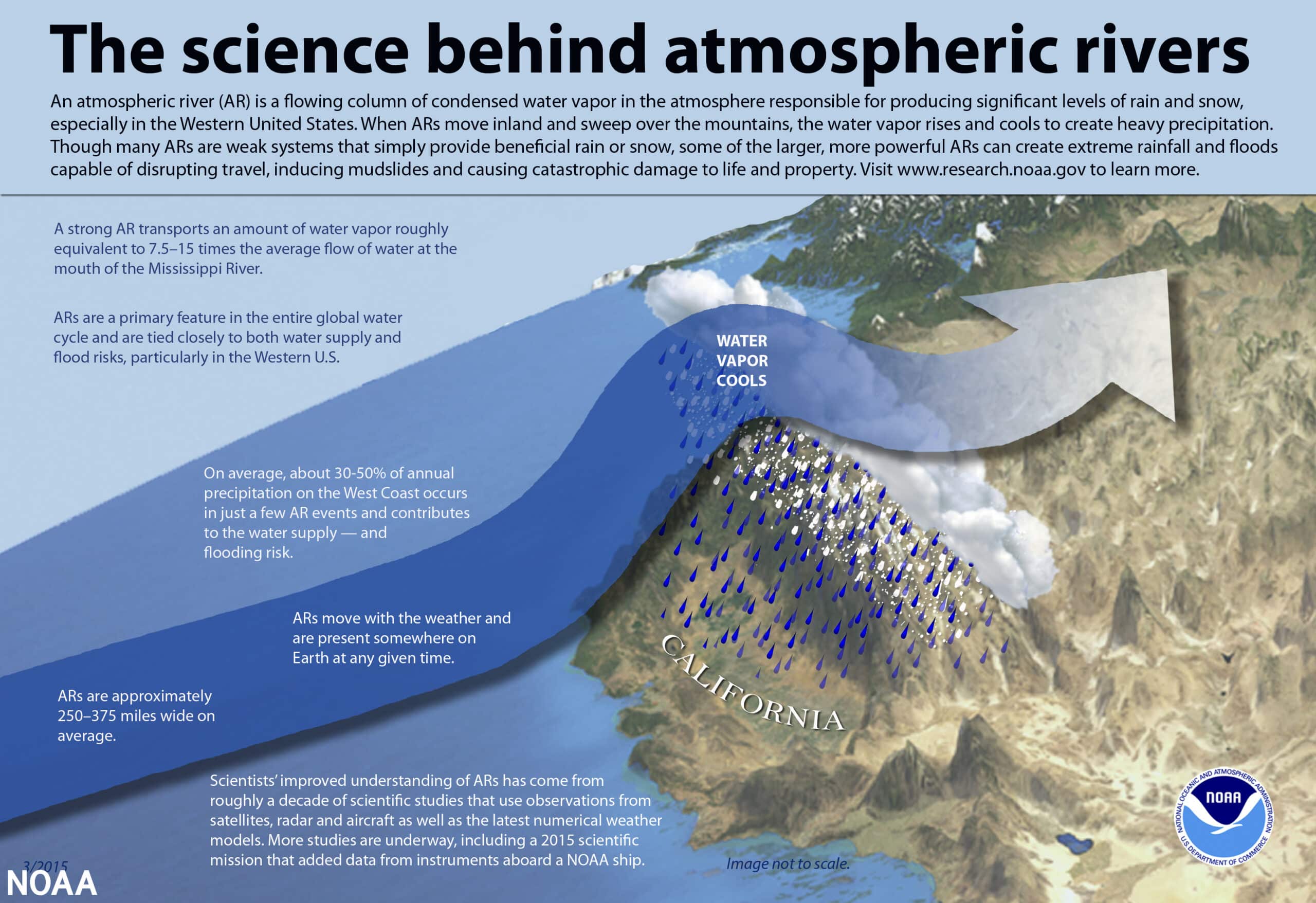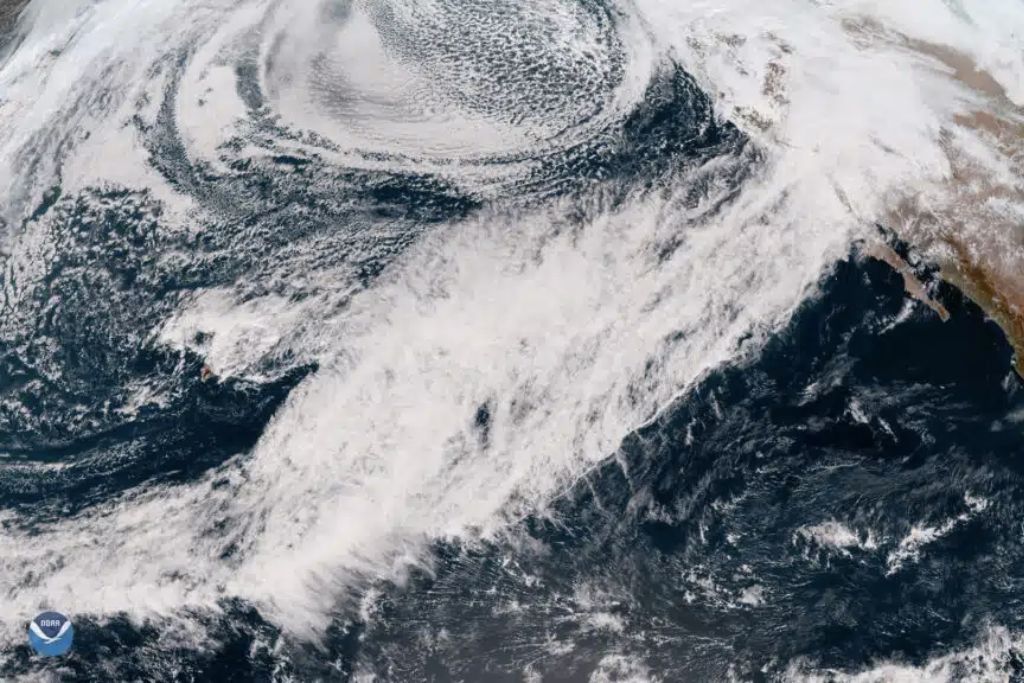Atmospheric rivers are essential for the transportation of precipitation occurring in the Northern and Southern Hemisphere. The rapidly changing climate is causing shifts in these long, flowing regions of the atmosphere, resulting in an increasing number of extreme weather events that bring about destruction across the world.
—
What Are Atmospheric Rivers?
Atmospheric rivers occur in the Earth’s atmosphere as a concentrated band of moisture and wind that transports large amounts of water vapor and are the largest and most important transport mechanisms of freshwater on Earth. Similar to terrestrial rivers, atmospheric rivers can vary in strength and size and can occur both in the Northern hemisphere – typically between December and February – and in the Southern hemisphere – typically between June and August, when extratropical cyclones are prevalent.
For atmospheric rivers to form, the following conditions are required:
- Strong low-level winds that act as a highway for water vapour to be transported across. The jet streams in the Northern and Southern hemispheres act as these highways, with speeds reaching as high as 442km/h (275mph).
- High moisture levels, which are a prerequisite for precipitation to occur.
- Orographic life, a phenomenon that occurs when an air mass moves from a low to a higher elevation as it moved over rising terrain, such as a mountain. As the air mass gains altitude, it quickly cools down, raising humidity in the air and eventually leading to the formation of clouds and, under the right conditions, precipitations.
Impacts of Atmospheric Rivers
Atmospheric rivers can have different impacts on ecosystems and global freshwater supply. Some aspects of atmospheric rivers are important as they provide water security for communities and keep the water cycle in balance.
Advantages of atmospheric rivers include the redistribution of freshwater supply across the planet as well as increased water levels and snowpack in watersheds. Given that only around 1.2% of all freshwater is surface water and thus daily available, redistribution of freshwater supply is crucial. Increased water levels in watersheds promote ecosystem biodiversity, replenish groundwater reserves, and nurture the overall health of a watershed. In cooler months, freshwater is stored as snowpacks, which then melts into liquid during warmer months, replenishing the watershed and bringing water back to normal levels. Additionally, albedo, the snowpacks’ ability to reflect sunlight – and thus heat – back to the atmosphere, helps cooling to Earth’s surface.

The science behind atmospheric rivers. Infographic: NOAA
Disadvantages of this weather phenomenon include landslides, mudslides, and major flooding.
When large volumes of rain carried by atmospheric rivers make landfall, they can lead to soil saturation, meaning soil is no longer capable of absorbing water, which instead accumulates and eventually leads to flooding. Moreover, if there is not enough vegetation in the area – for example as a result of a forest fire – and the slope is steep enough, abundant precipitation can result in landslides and/or mudslides. Lastly, a lack of atmospheric rivers can also result in droughts, which are associated with food insecurity and shortages as well as increased human conflicts.
The Role of Climate Change In Shaping Weather Patterns
According to a study published in October 2020, atmospheric rivers in the Southern Hemisphere have been shifting poleward by a rate of 0.24°, 0.27°, and 0.72° per decade over the past four decades. This shift, a direct result of anthropogenic forcing, has had repercussions on our oceans and atmospheric temperatures by altering the sea surface temperatures in the ocean, increasing concentrations of greenhouse gases in the atmosphere, and accelerating ozone depletion.
Atmospheric Rivers Around the World
As mentioned before, atmospheric rivers have become more frequent and intense in recent years.
On August 17, 2022, the North and South Islands of New Zealand were hit by an atmospheric river that resulted in unprecedented precipitation events. The large band of moisture transported huge amounts of precipitation, leading to devastating flooding across the country. Tākaka, a small town in the South Island, received one-third of its annual rainfall in just three days. Flooding displaced many communities and caused huge damages to their buildings and infrastructure. Over 400 homes were evacuated and entire roadways were washed out.
From December 2022 to March 2023, the California has experienced a total of 12 atmospheric river events. In January 2023, gale-force winds downed power lines, leaving more than hundreds of thousands of people across the state without electricity. In just a few weeks, several areas in central California received over half their average annual rainfall. While these atmospheric rivers mitigated the impacts of the years-long drought affecting the US country by increasing the soil moisture content, the amount of precipitation received was more than the landscape could handle, thus leading to floods that have cost more than one billion in damages.
You might also like: Seventh Consecutive Atmospheric River Since Christmas Rolls Through California With Bigger Storm Expected This Weekend
What Does the Future Hold?
With climate change knocking at our door and air and ocean temperatures rising, atmospheric rivers will only keep intensifying in strength, frequency, and length, with some studies suggest in that rainfall will increase by up to 40% more in a warming world.
Featured image: NOAA Satellites/Flickr


















